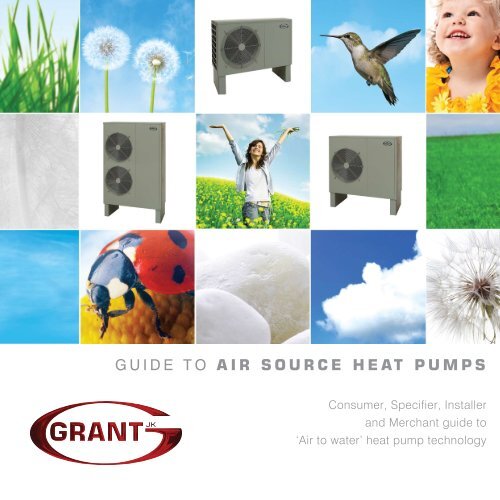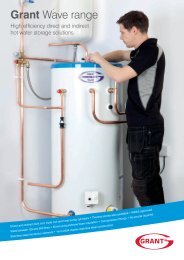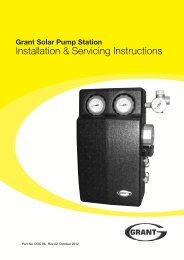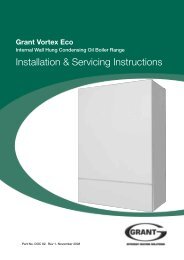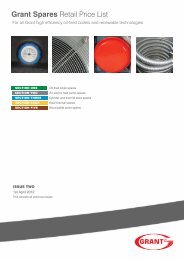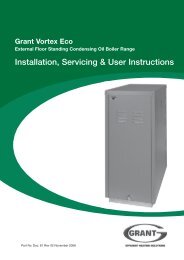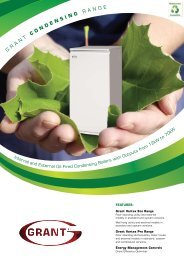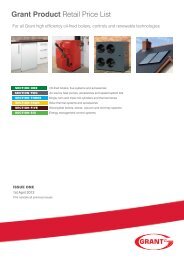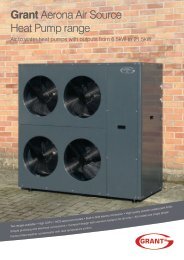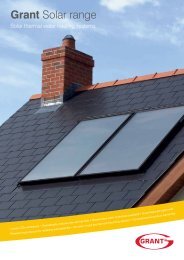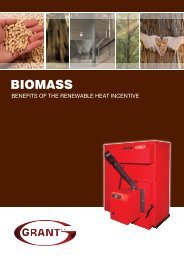GUIDE TO AIR SOURCE HEAT PUMPS - Grant UK
GUIDE TO AIR SOURCE HEAT PUMPS - Grant UK
GUIDE TO AIR SOURCE HEAT PUMPS - Grant UK
Create successful ePaper yourself
Turn your PDF publications into a flip-book with our unique Google optimized e-Paper software.
<strong>GUIDE</strong> <strong>TO</strong> <strong>AIR</strong> <strong>SOURCE</strong> <strong>HEAT</strong> <strong>PUMPS</strong>Consumer, Specifier, Installerand Merchant guide to‘Air to water’ heat pump technology
The most commonly asked questions aboutAir Source Heat PumpsQ. What are air source heat pumps (ASHP)?A. Air Source Heat Pumps use basic thermodynamic principles to convert latent/sensible heat (contained withinthe ambient air) into heat energy that can be used to provide heating and hot water. In this respect the device can beclassified as a renewable energy source because the heat in the ambient air is replenished by the sun.There are two types - ‘air to air’ and ‘air to water. Air to air heat pumps release the captured energy through an air heatexchanger, which is then forced (by fan) around the dwelling by trunking, or directly into the room. Most commercialbuildings use this type of heating medium. <strong>Grant</strong> Aerona ASHP are the air to water type. Air to water heat pumps releasethe energy into a water circuit which is then used in a wet heating system.Q. How do ASHP work?A. Air to water heat pumps employ the dynamics of the vapour/compression cycle used for many years in the basicrefrigeration process found within a domestic fridge. A low pressure, low boiling point liquid (refrigerant) is exposed toa higher temperature in the coil of the evaporator. The liquid boils off to a gas and in doing so, absorbs energy. Therefrigerant gas is then compressed to a higher pressure and temperature before passing through a heat exchanger whereit gives its heat energy to water. The heated water is then delivered to a cylinder or heating system. After passing throughthe heat exchanger the refrigerant condenses back into a liquid before starting the process again.2
Q. What is different about <strong>Grant</strong>’s approach to air source heat pumps?A. AIr source heat pumps generally fall into three categories:1) Units that have been designed specifically for heating only.2) Units that were originally designed for air conditioning (cooling), but have been modified to provide heating.3) Units that were originally designed for both cooling and heating with cooling the main function.The <strong>Grant</strong> Aerona falls into the first category, having been designed specifically for heating homes in the <strong>UK</strong> and Irishmarkets. This is particularly evident in the Aerona’s visual appearance and also its ease of installation.The unit is available in five sizes ranging from 6.5kW-15.5kW.Q. What is meant by the COP for a heat pump and how can I compareproducts?A. COP Stands for ‘Coefficient of Performance’. This is a ratio with no units, basically indicating the amount of energyrequired to run the compressor, compared with the amount of energy being produced by the heat pump, to heat thewater.Standard testing, carried out to EN14511 establishes a benchmark COP at a particular ambient and circuit watertemperature. This is 7 o C for ambient air and 35 o C for water flow temperature and usually produces a COP in the regionof 3.5. This means that for every kilowatt (kW) of energy used to run the compressor, 3.5kW of energy is being given tothe heating system in return. The <strong>Grant</strong> Aerona Range is approved to this standard and has achieved exceptional COP’sbetween 3.9 and 5.8Q. Is the <strong>Grant</strong> Aerona Air Source Heat Pump Range MCS approved?A. Yes, all models within the <strong>Grant</strong> Aerona Range are listed on the MCS Approved Register. Provided that the installer isalso MCS approved, householders will be able to access the Renewable Heat Incentive grant (RHI) due to be launched inApril 2011. For approval numbers, please visit the MCS website - www.microgenerationcertification.orgT: 01380 736920 W: WWW.GRANT<strong>UK</strong>.COM3
Q. As the stated kW output of an ASHP is established testing at 7 o C ambient airand 35 o C water flow temperature (EN14511 standard testing conditions), whathappens to the performance of the ASHP if the air temperature drops or therequired water temperature is set higher?A. All ASHP will have a decrease in output if the air temperature is cooler than the standard test conditions (STC). Thisis also true if the system water temperature is raised to a higher temperature than the STC. It is therefore vital that anaccurate heat loss calculation is carried out to ensure the sizing of the heat pump is correct.Not surprisingly, if the air temperature is higher, or system water temperature is lower, an increase in output can occur.Q. Why have <strong>Grant</strong> chosen to market an ASHP encompassing weathercompensation and an electrical backup?A. Heat pump equipment derived from the air conditioning industry is the result of many years of product development.Although they do work well, the technology tends to be over complicated for domestic heat pump applications and makesinstallation slow for heating engineers. Due to their design, this technology may require the assistance of a refrigerationtechnician for installation and commissioning.Weather compensation is not a new idea for the heating sector. <strong>Grant</strong> has taken tried and tested technology and givencustomers the benefit of incorporating it into every Aerona ASHP.As the COP of the heat pump is affected by weather conditions, it can sometimes result in poor performance andefficiency. <strong>Grant</strong> has built in an independent heating element to provide a boost in the rare times when the COP drops toinefficient levels.Q. How efficient is an ASHP compared with a gas or oil fired boiler?A. To compare efficiencies with gas/oil boilers in monetary terms is always going to be a moving target, as world pricesfor fossil fuels fluctuate. To get a reasonable indicator you have to establish how much energy is produced by, say a litreof fuel oil, along with the cost, and then compare it with the cost of a Kilowatt of electricity to run the heat pump and thepumps output. If the heat pump is more cost effective then the heat pump is more efficient. In environmental terms, theheat pump is vastly more beneficial as it is using solar energy contained within the ambient air to produce heat energy.4
Q. When the weather is cold will the ASHP still work?A. When the weather is cold the ambient air contains less heat energy. At lower ambient temperatures the energy requiredto boil off the refrigerant, will require more input from the internal compressor. The water will be heated, but at a slowerrate, so the efficiency of the heat pump reduces. Low temperatures of around –15 o C will affect the heat pump performancein this way.Q. Can an ASHP meet all the heating and hot water needs for a housethroughout the year?A. Under anything but the most severe weather conditions, provided the property is well insulated and the unit has beensized correctly, the heat pump will supply the necessary heating requirements for the majority of the year. However, in anysituation where the weather can be severe, a supplementary heat source will be required to maintain target temperature.This would normally be provided by a backup immersion (part of the weather compensation unit in the <strong>Grant</strong> AeronaRange), but could also be in the form of a supplementary gas/oil boiler.An ASHP works at a higher COP when run at lower flow temperatures, typically 35-50 o C. Domestic hot water is normallystored around temperatures of 60 o C, so it is therefore likely that a supplementary heat source in the form of a tankimmersion element may be required, especially if the heat pump is the only provider of domestic hot water and is notbeing assisted by solar thermal.Q. What water temperature will the ASHP generate?A. Even at a temperature as low as -15 o C, air contains a certain amount of heat. In the United Kingdom it is rare that ourexternal air temperature would fall below this point, meaning ASHP technology can be a very effective heating method. Intraditional terms an ASHP produces low temperature water, in comparison to traditional heating appliances. This is due tothe following:1) The physical properties of the refrigerants used are limited to the amount of energy that they can absorb and thereforegive up, further into the process.2) The ambient air contains insufficient heat energy to successfully boil off the refrigerant vapour.Refrigerants used throughout the industry can comfortably produce water temperatures in the region of 50 o C based oncurrent independent testing criteria.T: 01380 736920 W: WWW.GRANT<strong>UK</strong>.COM5
Q. Can I connect an ASHP to my existing hot water cylinder?A. Due to the lower water temperatures produced by a heat pump, any heat exchange taking place in an indirect cylinderwill require a coil with a larger surface area compared with that of a traditional cylinder. This will ensure efficient heattransfer. Therefore it is recommended that the cylinder be checked for suitability and changed for one designed for usewith heat pumps. <strong>Grant</strong> produce a range of ASHP cylinders, specifically for this application.Q. I am aware that an ASHP works well with under floor heating but can it alsowork with radiators?A. A heat pump will cope well when used with panel radiators, provided that the system is properly designed and thatthe building has a high level of insulation. Due to the lower temperatures involved, radiators have to be oversized and theheating will need to be on for longer periods, in order to meet the heating demand. Customer perceptions may be differentas the radiators will be cooler to touch, giving the impression that the heating is not functioning correctly, even thoughroom temperature targets are being met. Radiator and underfloor heating systems can also be combined.Q. Can I heat a swimming pool with an ASHP?A. Yes, an ASHP can be used to heat a swimming pool provided the system is correctly designed and the heat loss iscalculated. The system design must ensure that the swimming pool water does not come into direct contact with the heatpump components.6
Q. How easy is a <strong>Grant</strong> Aerona ASHP to install?A. A <strong>Grant</strong> Aerona ASHP is supplied fitted with the weather compensation unit and electrical backup. Only two pipeconnections are required from the house: heating system flow and return, and an electrical supply. The heat pump itselfshould be placed at least 300mm from the wall to ensure that there is an unobstructed air flow to the unit.The electrical supply should be fed from a dedicated MCB with a suitable external isolation switch, situated near the heatpump.Q. What cable size should be used to connect the ASHP to the mains supply?A. Cable size will vary dependent upon the size of heat pump installed, type of cable and its length of run. We recommendthat all electrical work is carried out by a registered and qualified electrician, in accordance with current legislation.Q. Which is best, a single or three phase electrical supply?A. The efficiency and capacity of both single and three phase units is virtually identical, but the majority of domestichouses in the United Kingdom are connected to single phase supplies. <strong>Grant</strong> Aerona Air Source Heat Pumps are availablein single phase only.Q. Where can you site an ASHP?A. An ASHP can be fitted almost anywhere externally, provided there is an unobstructed air flow available to the unit toensure trouble free efficient operation, and you take into consideration your pipe and cable runs to and from the property.8
Q. What is the defrost cycle?A. To ensure the unit operates as efficiently as possible, the evaporator matrix has to be kept ice free (as iceacts as an insulator). The ASHP will automatically switch to ‘defrost mode’ periodically to ensure that theevapourator stays clear.In the case of the <strong>Grant</strong> Aerona, this reverses the heat pumps refrigeration process for a shorrt time, therebysupplying latent heat in the form of hot gas to the evapourator, which defrosts any ice present. In normaloperating conditions the defrost cycle will not result in a deterioration of the dwelling’s core temperature.Q. How do you size a heat pump?A. In a monovalent system (e.g. in a new-build situation), the ASHP should be matched to 100% of the thermalheat loss for the property*.In a bivalent system (for existing buildings with an auxillary heat source) the ASHP should be sized to 60-70% ofthe thermal heat loss*.* The heat demand for the property should be accurately calculated and not estimated. You should always remember toallow for domestic hot water requirements.T: 01380 736920 W: WWW.GRANT<strong>UK</strong>.COM9
Q. How noisy is an ASHP?A. Heat pumps incorporate a fan and compressor that will generate a degree of background noise under normaloperation. As it is generally accepted that ASHP’s are located near to the property’s exterior walls for ease of pipe andpower cable runs, it is important that consideration is given to the amount of noise generated. Noise is measured indecibels or dB(A) and gives an indication of sound pressure level, usually measured at a distance of one meter. <strong>Grant</strong>Aerona ASHP produce around 52-58 dB(A) across the range.Acoustic considerations:Source of sound: dB: Perception:Silence 0 InaudibleWatch ticking 10 Very quietAir con in office 40 QuietConversation 60 MediumMotorcycle 70 LoudHGV 90 Very loudAirplane 130 UnbearableQ. Why fit an air source heat pump (ASHP) in preference to a ground sourceheat pump (GSHP)?A. The choice between the two could be down to the following:1) The difference in COP between ASHP and GSHP is minimal compared with the difference in cost of the equipment andinstallation.2) The installation of a GSHP may cause considerable disruption to the property and could require the services ofspecialist consultants and installers. In comparison, the installation of an ASHP is far easier to plan and carry out.3) For GSHP, the suitability of the property is a major factor, as they require either sufficient ground surface area, or asuitable local geology. No such considerations apply to ASHP.10
Q. What refrigerant is used in a <strong>Grant</strong> Aerona ASHP?A. The refrigerant used is R407 c, which is a Hydroflurocarbon (HFC) blend with a boiling point of –44 o C. An HFCrefrigerant is Ozone friendly. However, it should be remembered that the discharge of refrigerant is forbidden underEuropean and <strong>UK</strong> Law.Q. Can an ASHP be combined with other renewable technologies to provide amore energy efficient home?A. Absolutely, as long as a thermal store or a suitable cylinder is used in the initial design, then other technologies can beincorporated to make the whole system as efficient as possible. The technology that is most beneficial to incorporate insuch a system would be solar thermal.Q. What maintenance is required for a <strong>Grant</strong> Aerona ASHP and how often will itneed to be serviced?A. No intrusive servicing is required or indeed allowed under legislation unless undertaken by a qualified refrigerationengineer. The servicing routine is annual and limited to ensuring that the evaporator coil/matrix is clear of debris, which willsignificantly affect the performance of the heat pump if allowed to build up.T: 01380 736920 W: WWW.GRANT<strong>UK</strong>.COM
This leaflet is accurate at the time of printing but as <strong>Grant</strong> <strong>UK</strong> has a policy of continual improvement itmay be superseded. We reserve the right to amend specifications without prior notice. The statutoryrights of the consumer are not affected.All products manufactured under I.S. EN ISO 9001 and ISO 14001.THE GRANT ‘EZ-FIT FLUE’ SYSTEM is a Trade Mark of <strong>Grant</strong> Engineering Limited.®<strong>Grant</strong> Aerona, <strong>Grant</strong> Spira, <strong>Grant</strong> Vector, <strong>Grant</strong> Vortex, <strong>Grant</strong> Solar, <strong>Grant</strong> Aurora, <strong>Grant</strong> Sahara,<strong>Grant</strong> CombiSOL, <strong>Grant</strong> WinterSOL, <strong>Grant</strong> MonoWave, <strong>Grant</strong> DuoWave, <strong>Grant</strong> ThermaWave, Euroflameand Multi Pass are registered Trade Marks of <strong>Grant</strong> Engineering Limited. The contents of this leaflet arefully protected by copyright and nothing may be reproduced without permission from <strong>Grant</strong> <strong>UK</strong>.GRANT ENGINEERING (<strong>UK</strong>) LTDHOP<strong>TO</strong>N HOUSE, HOP<strong>TO</strong>N INDUSTRIAL ESTATE,DEVIZES, WILTSHIRE, SN10 2EUT: 01380 736920 F: 01380 736991E: SALES@GRANT<strong>UK</strong>.COM W: WWW.GRANT<strong>UK</strong>.COMASG 09/10 <strong>UK</strong>


